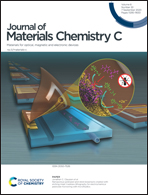Highly conductive wet-spun PEDOT:PSS fibers for applications in electronic textiles†
Abstract
The emerging field of electronic textiles is currently hindered by a lack of mechanically robust fibers and yarns that efficiently conduct electricity. Conjugated polymer fibers are promising candidates to meet those requirements. In this work, a wet-spinning process is described to fabricate PEDOT:PSS fibers with electrical conductivities up to 3663 ± 326 S cm−1, Young's moduli up to 22 GPa and tensile strength of 550 MPa, through inclusion of a sulfuric acid drawing step. The mechanism by which the sulfuric acid drawing step enhances the electrical and mechanical properties of the fibers is investigated. Moreover, the electrical conductivity of these fibers was further increased to 4039 ± 215 S cm−1 by immersing the fibers in sulfuric acid for additional time, at the expense, however, of lowering their Young's modulus and tensile strength. Additionally, we demonstrate the use of the fibers in various electronic textile applications such as: (a) flexible textile interconnections in an LED circuit, (b) a proof of concept thermochromic fiber bundle that changes color on demand, (c) a thermoelectric textile device using the fibers as the p-type legs, and (d) using the fibers as the channel in an organic electrochemical transistor to build an LED dimmer. This work presents a unique type of material with the potential of becoming a cornerstone in the emerging field of electronic textiles.



 Please wait while we load your content...
Please wait while we load your content...
